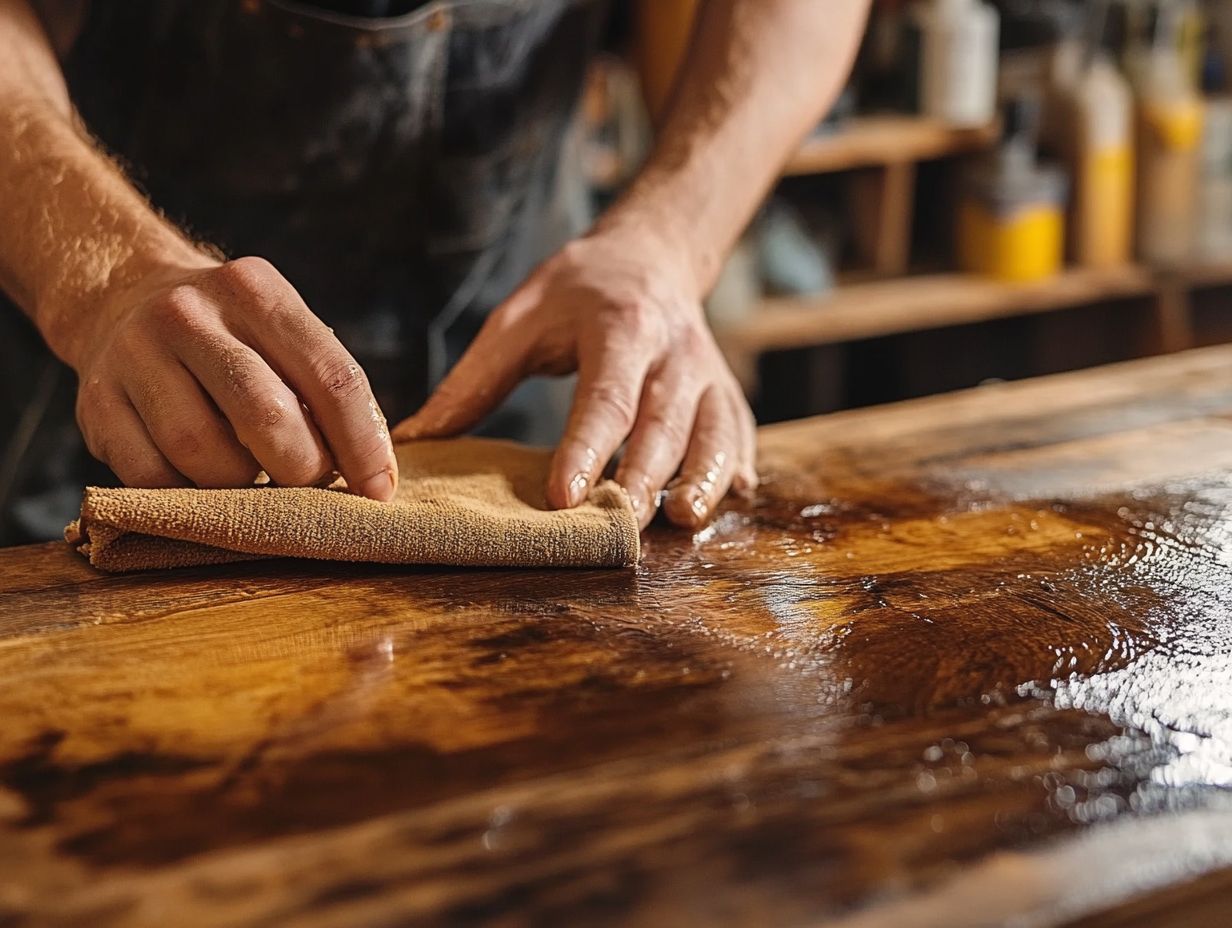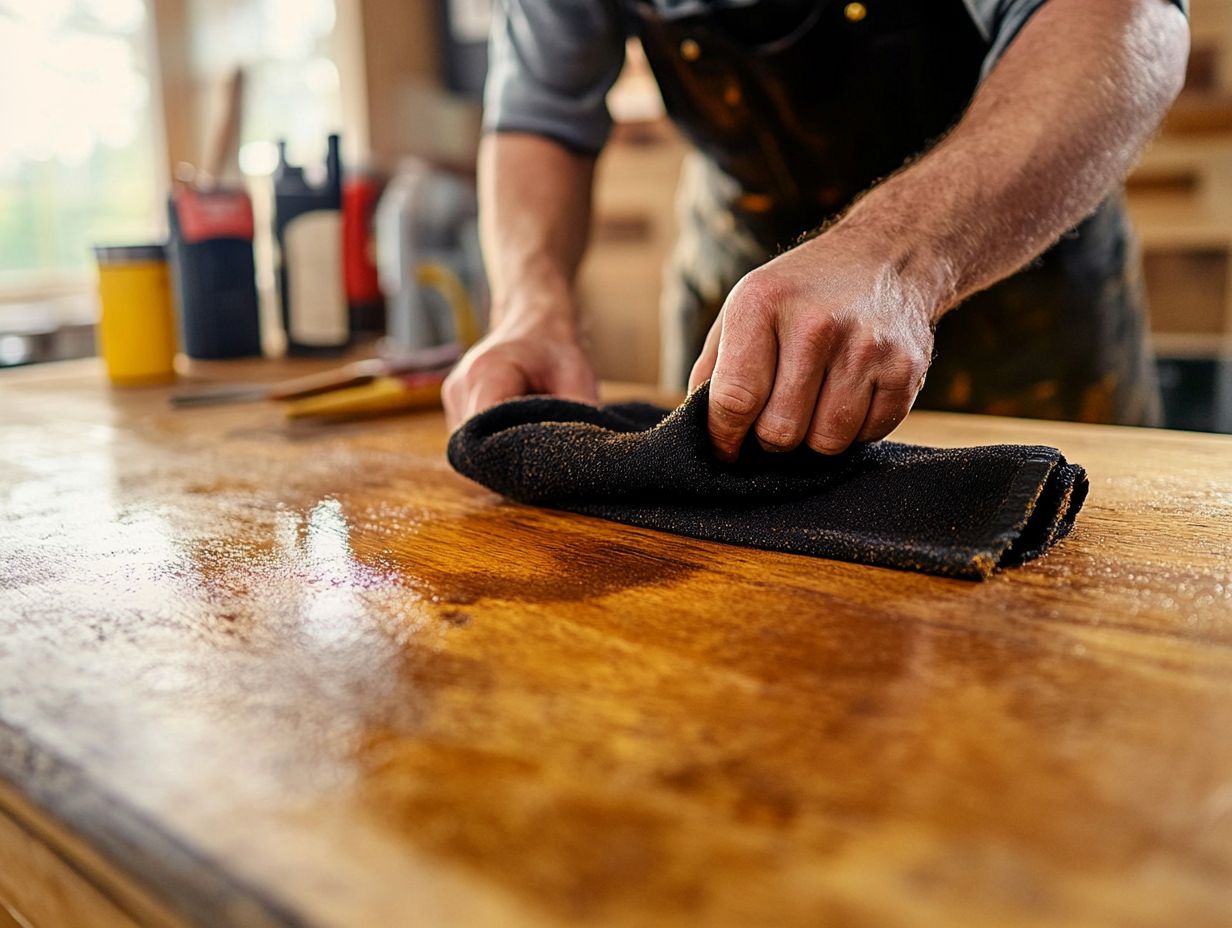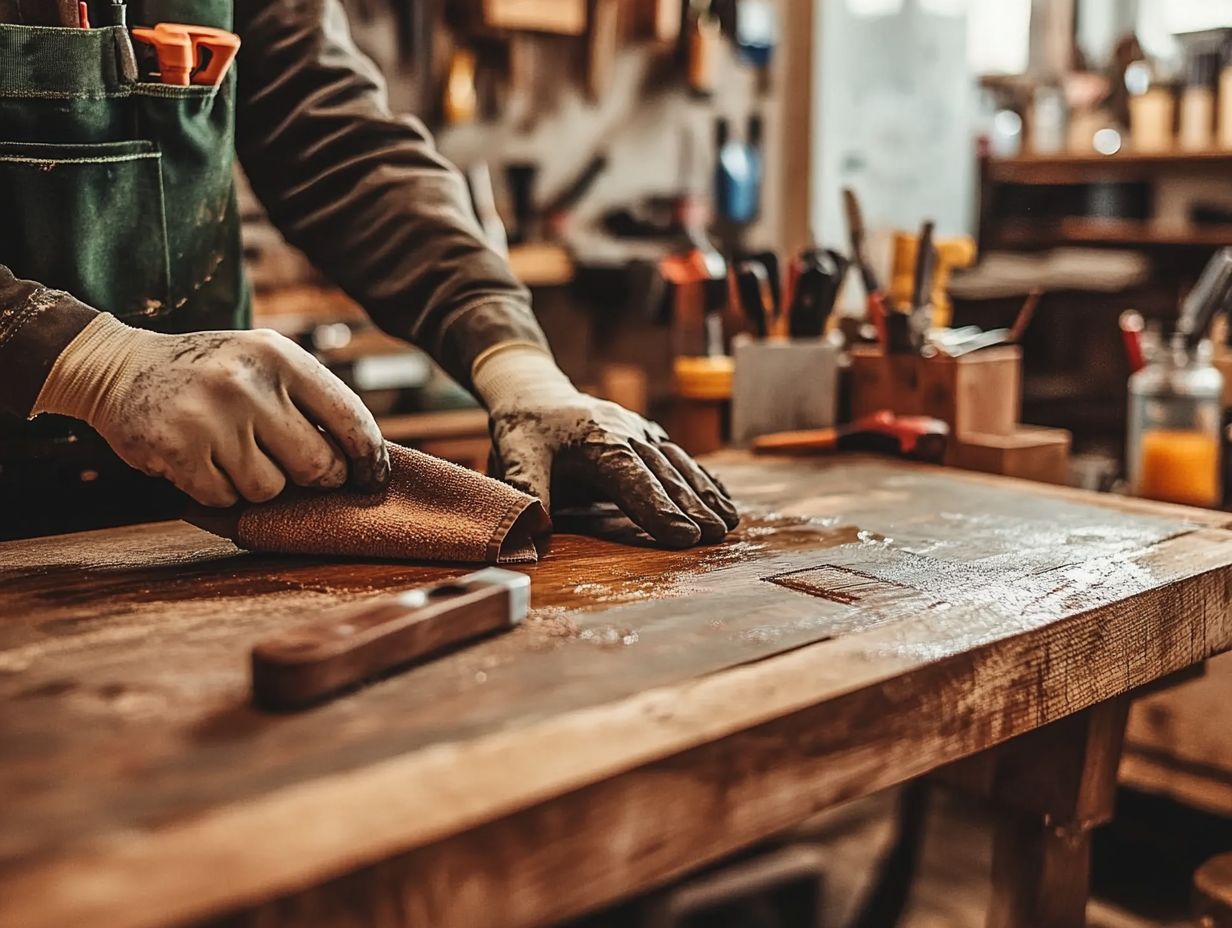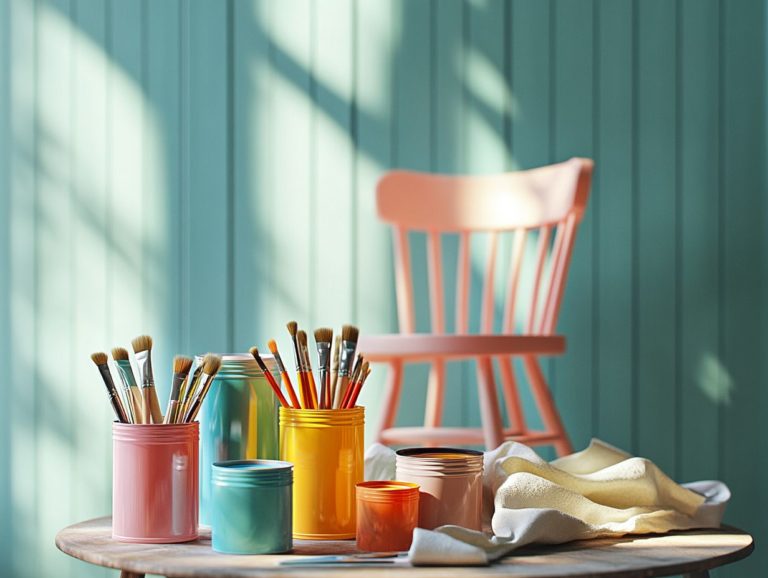DIY Restoration: Fixing Scratches on Wood
Scratches on wood can be undeniably frustrating, stealing the spotlight from your beloved furniture or flooring. Don t let scratches ruin your beautiful furniture! Let s dive into how you can quickly restore its charm!
Whether you’re dealing with a minor scuff or a deeper gouge, understanding the types of scratches and their causes is crucial for effective repair. This guide will equip you with the necessary tools and materials for fixing, offering a detailed step-by-step process to tackle those scratches.
You ll also find valuable tips on how to prevent future damage, ensuring your wood surfaces maintain their beauty as brilliantly as the day you brought them home.
Contents
- Key Takeaways:
- Tools and Materials Needed
- Step-by-Step Process for Fixing Scratches
- Alternative Methods for Removing Scratches
- Tips for Preventing Future Scratches
- Frequently Asked Questions
- 1. How can I fix scratches on wood furniture using DIY restoration methods?
- 2. Can I use regular household products to fix scratches on wood?
- 3. What tools do I need for DIY restoration of scratches on wood?
- 4. Can I fix deep scratches on wood furniture without refinishing the whole piece?
- 5. What if I can’t find the exact stain color for my wood furniture?
- 6. Any tips for DIY restoration of scratches on wood?
Key Takeaways:

- Understand the different types of wood scratches and their causes to choose the right repair method.
- Prepare the surface, apply filler, sand, and finish for successful DIY fixing of scratches on wood.
- Consider alternative methods like household items or seeking professional help for removing deep or extensive scratches.
Understanding Wood Scratches
Understanding wood scratches is essential for preserving the beauty and longevity of your wooden furniture. Scratches can show up from all sorts of sources like your playful pet or that clumsy kitchen moment!
By knowing how to identify different types of scratches and their causes, you can choose the appropriate repair methods. This ensures that the finish remains intact while restoring your furniture to its original charm.
With a clear grasp of the common damage that wooden tables and furniture face, you can effectively plan for routine care and repairs, safeguarding the integrity of these cherished pieces.
Types of Scratches and Causes
Understanding the different types of scratches on your wooden furniture is crucial for effective repair. They can typically be categorized into deep and shallow scratches, each resulting from various causes think pet accidents or kitchen mishaps.
Deep scratches tend to happen when heavier objects fall or scrape across the surface, penetrating both the finish and the wood beneath. On the other hand, shallow scratches often emerge from everyday activities, like shifting dining chairs or children playing with toys.
Common household accidents can arise from bumping furniture with a vacuum cleaner or dragging boxes during a move, both of which contribute to the gradual wear and tear over time. By recognizing these factors, you can implement preventive measures like using furniture pads, handling items with care during cleaning, and being vigilant about sharp or heavy objects around your wooden surfaces.
Tools and Materials Needed
When it comes to repairing scratches on your wooden furniture, having the right tools and materials is essential for successful fixing. Key supplies for addressing wooden tables and furniture include wood fillers, various cleaning agents, and specific tools designed for the repair technique you’re using.
Each component is crucial, whether you’re filling deep scratches or applying a cleaning solution for routine upkeep. Armed with the right resources, you can effectively address damage and preserve the aesthetic charm of your furniture.
Essential Supplies for Repair
To effectively repair scratches on your wooden furniture, gather some essential supplies: wood fillers, cleaning materials, and specialized tools like 0000 steel wool and marker pens. These will help you blend your repairs seamlessly into the existing finish.
Wood fillers are vital for tackling deeper scratches, offering a smooth surface for fixing. Just apply the filler to the damaged area and let it dry thoroughly before sanding it down for a flawless finish.
For routine upkeep, having the right cleaning materials is crucial. They not only maintain the wood’s natural sheen but also prevent debris buildup that could worsen any damage.
If you encounter minor surface blemishes, Mocha Scratch-Off is your best friend, while the marker pen is perfect for quick touch-ups. Together, these effective tools ensure your wooden pieces look polished, enhancing both their longevity and beauty.
Let s get started on restoring your wooden furniture today!
Step-by-Step Process for Fixing Scratches

The step-by-step process for repairing scratches on wooden furniture requires careful preparation and the meticulous application of fillers. These finishing touches ensure the repair seamlessly integrates with the existing wood finish.
To restore your furniture effectively, it s essential to adopt a systematic approach. This includes:
- Surface preparation
- Selecting the right filler based on the scratch type
- Sanding to achieve a flawlessly smooth finish
Whether you’re tackling shallow or deep scratches, every step plays a vital role in rejuvenating your furniture’s aesthetic appeal and extending its lifespan.
Preparing the Surface
Preparing the surface of your wooden furniture is an important first step in the scratch repair process. This ensures the wood is clean and primed for applying fillers or other restoration techniques.
Don t overlook this foundational aspect; the effectiveness of your repair hinges on the surface condition. Use gentle wood cleaners or natural solutions to remove dust, grime, and oils that could compromise adhesion.
A thorough preparation technique, like lightly sanding the scratched area, creates a smooth base for your restoration methods. By investing time in this crucial process, you ll significantly enhance both the durability and appearance of your repairs, leading to a more polished final result.
Applying the Filler
Applying the filler correctly is key to repairing wood scratches effectively. It not only fills the damaged areas but also ensures that your repair blends seamlessly with the surrounding wood grain.
To achieve a flawless finish, employ specific blending techniques. For example, using a product like Minwax wood filler can significantly enhance your results. Begin by selecting the right color that matches your wood; this step is essential for a uniform appearance.
After applying the filler, use a putty knife (a flat tool for spreading) to push it evenly into the scratches. Once it dries, gently sand the area with fine-grit sandpaper to create a smooth transition at the edges. Finally, apply a suitable stain or sealer to offer additional protection and harmonize the repaired area with the rest of your surface.
Sanding and Finishing
Sanding and finishing are vital for fixing wood scratches. These steps help you achieve a flawlessly smooth surface and restore the original finish of your furniture, making the repair nearly invisible.
By meticulously abrading the wood, the sanding process eliminates any irregularities and imperfections, providing a pristine canvas for your finishing products. It’s crucial to select the right grit: start with coarser options and gradually move to finer grades for the best results.
For delicate surfaces, using 0000 steel wool can be particularly advantageous, as it smooths effectively without jeopardizing the wood grain. Explore exciting finishing products like oils, stains, and varnishes to enhance your furniture!
Alternative Methods for Removing Scratches
Exploring alternative methods for removing scratches offers homeowners an array of options. You can choose from simple household items for minor scratches or consider seeking professional restoration techniques for more severe damage to your wooden furniture.
Each approach presents unique benefits, allowing you to tailor your strategy based on the specific needs of your pieces. Don’t hesitate to try these methods and see which works best for your furniture!
Using Household Items

Many homeowners discover that everyday household items, like a simple oil and vinegar mixture or vegetable oil, can work wonders to restore the appearance of minor scratches on wooden furniture without extensive repairs.
These alternatives not only save you money but are also typically found in most kitchens. Gently applying the oil and vinegar mixture with a soft cloth penetrates the wood, enhancing its natural shine and filling in shallow scratches. Using vegetable oil also works wonders just dab a small amount onto a cloth and rub it into the scratched area in a circular motion.
For deeper scratches, combining these methods with a bit of beeswax can create a protective barrier. Homeowners often appreciate that these DIY restoration tips for refinishing wood deliver impressive results with minimal effort.
Professional Restoration Options
For more severe scratches or extensive damage, you might consider professional fixing methods that use specialized techniques and products, like Mohawk Scratch-Off or Howard Restore-A-Finish, to achieve the best results.
The need for these interventions often stems from issues such as deep gouges, water damage, or significant wear and tear that traditional DIY methods simply can’t fix. For those interested in restoring cherished items, DIY restoration: refreshing old wooden toys can provide effective strategies. Professionals typically utilize techniques like sanding, refinishing, or even re-staining to restore the original beauty of your surfaces.
By using products specifically designed for the materials involved, they ensure the integrity of the restoration process. Techniques such as heat application (using heat to help the wood fibers recover) or filler compounds may also be employed to achieve a seamless finish. These methods enhance appearance and extend the longevity of the affected surfaces, making professional restoration a wise choice for discerning homeowners.
Tips for Preventing Future Scratches
Preventing future scratches on your wooden furniture is vital for preserving its elegant appearance and extending its lifespan. Establishing a routine care regimen that includes regular cleaning and protective measures can significantly diminish the risk of scratches from everyday activities or unforeseen accidents.
Understanding the common hazards and taking proactive steps allows you to enjoy the beauty of your wooden tables and furniture without the constant worry of potential damage over time.
Proper Maintenance and Care
Proper maintenance and care for your wooden furniture are essential for preserving its beauty and functionality, ensuring it remains scratch-free and in excellent condition for years to come.
Routine techniques, such as regularly dusting with a soft, lint-free cloth, can dramatically reduce the risk of scratches, as tiny particles can act like sandpaper on surfaces. It’s wise to apply a high-quality furniture polish periodically, which not only enhances shine but also adds a protective layer.
Using coasters and felt pads beneath items on wooden tables can further safeguard against unsightly marks. Establishing a cleaning schedule that incorporates suitable wood-safe cleaning supplies will significantly contribute to the longevity of your furniture.
By investing time in these simple maintenance tasks, you can enjoy the enduring elegance and durability of your wooden pieces without the worry of wear and tear.
Frequently Asked Questions
1. How can I fix scratches on wood furniture using DIY restoration methods?

There are several methods you can try, depending on the severity of the scratches. For shallow scratches, using a mixture of equal parts vinegar and olive oil can help buff them out. For deeper scratches, you may need to use a wood filler and a stain that matches the wood color.
2. Can I use regular household products to fix scratches on wood?
Yes! Common household items can help you restore scratches on wood. A mixture of vinegar and olive oil works wonders for shallow scratches.
You can also rub a walnut or a damp tea bag over the scratches to blend them in seamlessly.
3. What tools do I need for DIY restoration of scratches on wood?
Besides the household items mentioned, you’ll need some sandpaper, a substance to fill in gaps, and a stain that matches your wood color. Most hardware stores carry these items.
4. Can I fix deep scratches on wood furniture without refinishing the whole piece?
Absolutely! You can use a substance to fill in gaps and a matching stain to fill deep scratches. Then apply a clear protective finish or wax to safeguard your repair and match it with the rest of your furniture.
5. What if I can’t find the exact stain color for my wood furniture?
If you can t find an exact match, try mixing different stains to create a custom color. You can also use colored wax or markers made for wood to blend in the scratches.
6. Any tips for DIY restoration of scratches on wood?
Always test products on a small, hidden area first to ensure they won t damage the wood. Clean and dry the surface before you start, and carefully follow the instructions on any products you use.






